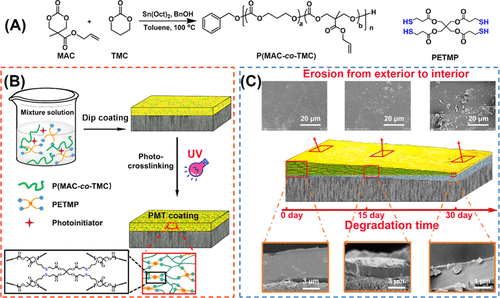当前位置:
X-MOL 学术
›
ACS Appl. Bio Mater.
›
论文详情
Our official English website, www.x-mol.net, welcomes your feedback! (Note: you will need to create a separate account there.)
Photo-Cross-Linked Polycarbonate Coating with Surface-Erosion Behavior for Corrosion Resistance and Cytocompatibility Enhancement of Magnesium Alloy
ACS Applied Bio Materials ( IF 4.7 ) Pub Date : 2020-06-16 , DOI: 10.1021/acsabm.0c00411 Kai Pan 1 , Xiaojie Li 1 , Long Meng 1 , Liu Hong 1 , Wei Wei 1 , Xiaoya Liu 1
ACS Applied Bio Materials ( IF 4.7 ) Pub Date : 2020-06-16 , DOI: 10.1021/acsabm.0c00411 Kai Pan 1 , Xiaojie Li 1 , Long Meng 1 , Liu Hong 1 , Wei Wei 1 , Xiaoya Liu 1
Affiliation

|
Absorbable magnesium (Mg) materials are promising for medical implant applications. However, their corrosion rate and potential toxicity remain a challenge. Herein, a photo-cross-linked coating with suitable durability and unique surface-eroding behavior for enhancement of anticorrosion property and cytocompatibility of AZ31 Mg alloy was developed. The biodegradable allyl-functional polycarbonate, poly[(5-methyl-5-allyloxycarbonyl-1,3-propanediol carbonate)-co-(trimethylene carbonate)] [P(MAC-co-TMC), PMT], was first synthesized by ring-opening copolymerization. The PMT copolymer, pentaerythritol tetrakis(3-mercaptopropionate), and a photoinitiator were then applied on AZ31 Mg alloy by dip coating, and these films were cross-linked via the subsequent photoinitiated thiol–ene click reaction. The poly(l-lactide) (PLLA) and poly(1,3-trimethylene carbonate) (PTMC) coatings without cross-linking were prepared and used as control. Our results show that the cross-linked PMT coatings exhibited superior mechanical properties compared with PLLA and PTMC coatings. Meanwhile, the surface-erosion behavior of the cross-linked PMT coatings remained, as confirmed by scanning electron microscopy analysis. As a result, the cross-linked PMT-coated Mg alloy showed lower corrosion rates, better in vitro corrosion resistance, and much lower cytotoxicity, compared with bare Mg and ones coated with PLLA and PTMC coatings. Results indicate that the cross-linked PMT coatings with unique surface-erosion behavior and good cytocompatibility might be promising to improve the safety and success rate of Mg-based devices and implants.
中文翻译:

具有表面侵蚀行为的光交联聚碳酸酯涂层增强镁合金的耐腐蚀性和细胞相容性
可吸收镁 (Mg) 材料有望用于医疗植入物应用。然而,它们的腐蚀速率和潜在毒性仍然是一个挑战。在此,开发了一种具有合适耐久性和独特表面侵蚀行为的光交联涂层,以提高 AZ31 镁合金的耐腐蚀性和细胞相容性。可生物降解的烯丙基官能团聚碳酸酯,聚[(5-甲基-5-烯丙氧基羰基-1,3-丙二醇碳酸酯) -co- (三亚甲基碳酸酯)][P(MAC - co -TMC),PMT],首先通过以下方法合成开环共聚。然后将 PMT 共聚物、季戊四醇四(3-巯基丙酸酯)和光引发剂通过浸涂法涂敷在 AZ31 镁合金上,这些薄膜通过交联随后的光引发硫醇-烯点击反应。制备了没有交联的聚 ( l-丙交酯) (PLLA) 和聚 (1,3-碳酸三亚甲基酯) (PTMC) 涂层并用作对照。我们的结果表明,与 PLLA 和 PTMC 涂层相比,交联 PMT 涂层表现出优异的机械性能。同时,通过扫描电子显微镜分析证实,交联 PMT 涂层的表面侵蚀行为仍然存在。结果,交联的 PMT 涂层镁合金表现出较低的腐蚀速率,在体外表现更好与裸镁和涂有 PLLA 和 PTMC 涂层的镁相比,耐腐蚀性和细胞毒性要低得多。结果表明,具有独特表面侵蚀行为和良好细胞相容性的交联 PMT 涂层可能有望提高镁基器械和植入物的安全性和成功率。
更新日期:2020-07-20
中文翻译:

具有表面侵蚀行为的光交联聚碳酸酯涂层增强镁合金的耐腐蚀性和细胞相容性
可吸收镁 (Mg) 材料有望用于医疗植入物应用。然而,它们的腐蚀速率和潜在毒性仍然是一个挑战。在此,开发了一种具有合适耐久性和独特表面侵蚀行为的光交联涂层,以提高 AZ31 镁合金的耐腐蚀性和细胞相容性。可生物降解的烯丙基官能团聚碳酸酯,聚[(5-甲基-5-烯丙氧基羰基-1,3-丙二醇碳酸酯) -co- (三亚甲基碳酸酯)][P(MAC - co -TMC),PMT],首先通过以下方法合成开环共聚。然后将 PMT 共聚物、季戊四醇四(3-巯基丙酸酯)和光引发剂通过浸涂法涂敷在 AZ31 镁合金上,这些薄膜通过交联随后的光引发硫醇-烯点击反应。制备了没有交联的聚 ( l-丙交酯) (PLLA) 和聚 (1,3-碳酸三亚甲基酯) (PTMC) 涂层并用作对照。我们的结果表明,与 PLLA 和 PTMC 涂层相比,交联 PMT 涂层表现出优异的机械性能。同时,通过扫描电子显微镜分析证实,交联 PMT 涂层的表面侵蚀行为仍然存在。结果,交联的 PMT 涂层镁合金表现出较低的腐蚀速率,在体外表现更好与裸镁和涂有 PLLA 和 PTMC 涂层的镁相比,耐腐蚀性和细胞毒性要低得多。结果表明,具有独特表面侵蚀行为和良好细胞相容性的交联 PMT 涂层可能有望提高镁基器械和植入物的安全性和成功率。



























 京公网安备 11010802027423号
京公网安备 11010802027423号